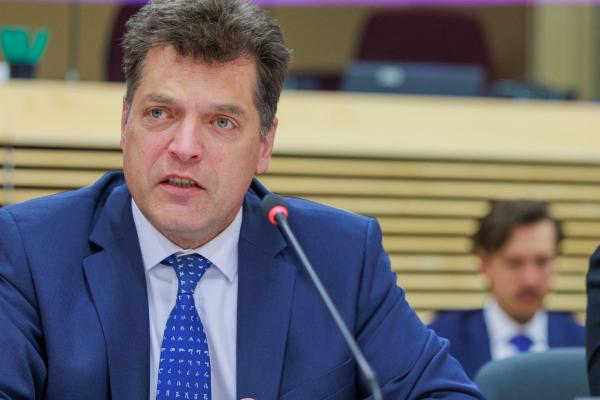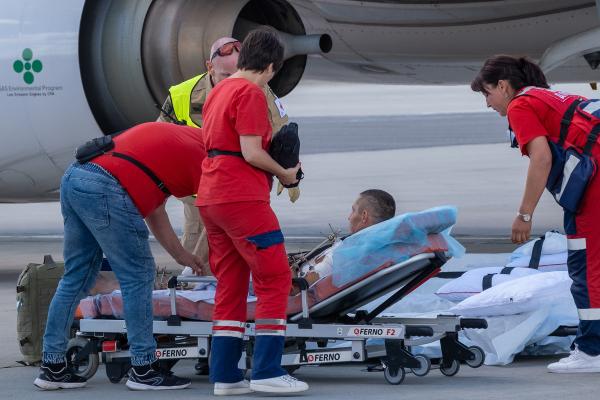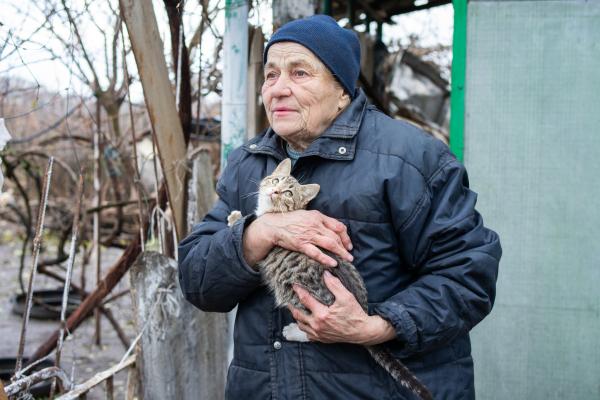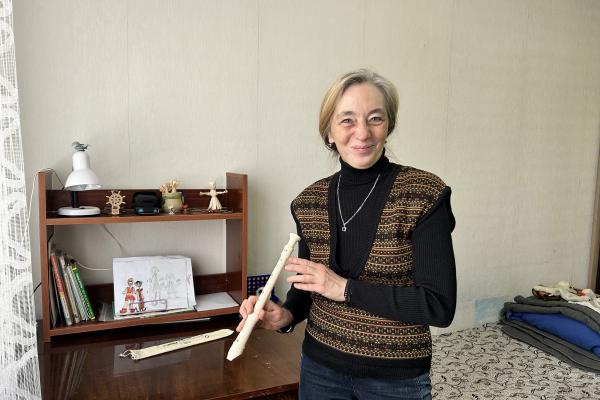Introduction
Russia’s war on Ukraine has continued to escalate in 2024 and shows no signs of abating.
Heavy fighting and attacks continue to endanger the lives of civilians and cause severe damage to housing, water and electricity supply, heating, and public infrastructure such as schools and health facilities. Millions of people have limited or no access to basic services.
The EU has mobilised all available resources to enable emergency assistance into Ukraine.

In February 2022, the Russian invasion of Ukraine triggered the fastest-growing displacement crisis in the world. Millions of people were forced to leave Ukraine, while millions more were displaced within the country.
The majority of those fleeing Ukraine were women and children.
Currently, about 3.6 million people are believed to be internally displaced. Meanwhile, many others are still stranded in affected areas, either unwilling or unable to leave due to military action.
An estimated 14.6 million people need humanitarian assistance in 2024.
Needs inside the country
The situation is most severe in eastern Ukraine, especially along the frontlines, in southern Ukraine, and in the Russian-occupied territories.
Russia’s war on Ukraine has provoked serious humanitarian challenges. Ensuring safe access for humanitarian organisations is essential to deliver relief items and enable safe evacuations from areas under attack.
Millions of people do not have access to basic services, including water, electricity, and heating.
The war has provoked significant protection challenges as civilians are exposed to shelling, armed violence, mines, family separation, looting or eviction, and loss off safe housing and shelter
The safety risks for women and girls are extremely worrying, as well as the situation of the most vulnerable groups (children, older persons, persons with disabilities, and LGBTIQ+ people). It is estimated that at least 2.5 million people, primarily women and girls, require prevention and response services to gender-based violence.
Continuous attacks also give rise to mental health care needs. Nearly 10 million people are at risk of or are living with a mental health condition. These include stress, anxiety, depression, and post-traumatic stress disorder. Children’s situation is especially worrying due to conflict activity, hindered access to safe education and limited opportunities for social interaction.
The international community is extremely concerned about the violations of international humanitarian law and war crimes.
How are we helping?
The EU’s largest civil protection operation to date
To provide emergency assistance to Ukrainians, the European Commission is coordinating its largest ever operation under the EU Civil Protection Mechanism.
All 27 EU countries, plus Norway, Türkiye, North Macedonia, Iceland, and Serbia, have offered in-kind assistance ranging from medical supplies and shelter items to vehicles and energy equipment.
The EU has established logistical hubs in Poland, Romania, and Slovakia to channel the items to Ukraine more efficiently. To date, more than 145,000 tonnes of aid has been delivered.
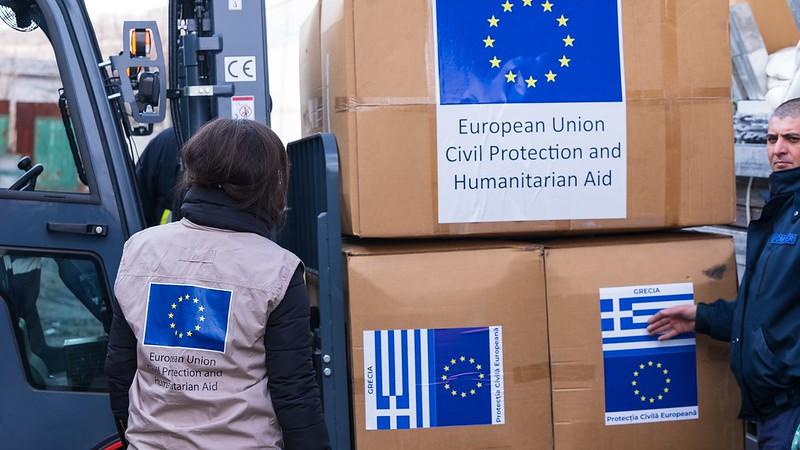
Given the immense need for emergency equipment in Ukraine, the EU has deployed assistance from its rescEU stockpiles, including:
- power generators
- medical equipment
- temporary shelter units
- water treatment stations in response to Nova Kakhovka dam breach
- specialised equipment for public health risks such as chemical, biological, radiological, and nuclear threats.
Also, the EU is coordinating medical evacuations of Ukrainian patients in urgent need of treatment, transferring them to hospitals across Europe to receive specialised care. In September 2022, the EU opened a hub in Rzeszów, Poland, to facilitate these medical evacuations. The EU Medevac Hub offers treatment to patients arriving from Ukraine before they are flown out to a hospital in another European country.
In April 2023, Ukraine joined the EU Civil Protection Mechanism as a participating state. Established in 2001, the Mechanism aims to strengthen the cooperation between the EU Member States and 10 participating states on civil protection to improve prevention, preparedness, and response to disasters.
EU humanitarian aid in Ukraine
Since February 2022, the European Commission has allocated €926 million for humanitarian aid programmes to help civilians affected by the war in Ukraine. This includes:
- €860 million for Ukraine
- €66 million for refugees that have fled to neighbouring Moldova.
For Ukraine, the EU has mobilised €485 million in humanitarian assistance for 2022, €300 million in 2023, and €75 million in 2024.
EU humanitarian funding is helping people inside Ukraine by providing them with (i) food, (ii) water, (iii) essential household items, (iv) health care, including mental health and psychosocial support, (v) emergency and winterised shelter, (vi) protection, including education in emergencies, and (vii) cash assistance to help cover their basic needs.
Our partners are present across the country and mobilising assistance on the ground.
Between January and November 2023, 10.5 million Ukrainians, including in hard-hit-areas, have received humanitarian support in Ukraine thanks to the EU and other donors.
Since January 2023:
- over 4.1 million people have received food assistance
- health interventions or supplies have benefited 7.5 million people
- cash assistance has reached 3.7 million people
- critical protection services have been extended to 4.5 million people
- almost 6.5 million people have regained access to clean water and essential hygiene and sanitation services.

Homecoming dreams: a story of resilience and rebuilding
18-year-old Ihor lives with cerebral palsy. Following Russia's full-scale invasion of Ukraine, he found himself at the centre of intense fighting. Every explosion resonated in him with a sense of physical pain.
The shelling destroyed Ihor's house, but it was later restored with the financial support of the European Union and Czech NGO People in Need.
Present in the country since 2014
The EU has been delivering humanitarian assistance to Ukraine since February 2014.
EU humanitarian offices in Ukraine play a key role in facilitating humanitarian coordination and information sharing among various organisations, including donors, authorities and humanitarian partners. EU humanitarian experts are also carrying out regular field missions in all affected regions of Ukraine to assess the needs and monitor EU-funded actions.
EU-funded humanitarian assistance is provided in line with the humanitarian principles of humanity, neutrality, impartiality and independence. It is delivered through the UN humanitarian agencies, non-governmental organisations and the International Committee of the Red Cross, as well as many local aid organisations partnering with them.
Timeline
- 20 February 2024EU provides an additional €83 million in humanitarian aid to support people affected by Russia’s war on Ukraine
€75 million is allocated for humanitarian projects in Ukraine to provide emergency aid such as access to basic needs, shelter, clean water, healthcare and education.
€8 million is allocated for humanitarian support of Ukrainian refugees and hosted communities in Moldova.
- 14 November 2023EU boost humanitarian funding to Ukraine with €100 million for Ukraine and €10 million for Moldova
This new funding will help the EU’s humanitarian partners to provide essential services like cash assistance, food, water, shelter, health care, psychosocial support, and protection.
- 6 June 2023Nova Kakhovka dam breach
In response to the disastrous breach of the Nova Kakhovka dam, the EU mobilised immediate assistance to Ukraine via (i) its Civil Protection Mechanism, (ii) deployment of its rescEU reserves, and (iii) via its humanitarian partners.
- 20 April 2023Ukraine joins the EU Civil Protection Mechanism
On 21 April, Ukraine became a participating state of the EU Civil Protection Mechanism – the European solidarity framework that helps countries overwhelmed by a disaster.
- 20 April 2023The EU tops up its humanitarian aid to Ukraine with €55 million
This new humanitarian funding will notably focus on preparing for next winter to ensure an extra layer of protection to those in need.
- 3 February 2023New humanitarian funding €145 million for Ukraine
During the EU-Ukraine summit in Kyiv, the EU mobilised further €145 million in humanitarian aid to Ukraine.
- 19 October 2022EU announces new rescEU reseve to provide emergency shelter to displaced Ukrainians
The EU has developed a new rescEU shelter reserve. It will be put into immediate use in Rivne, Bucha and Kharkiv regions to provide temporary shelter to internally displaced persons.
- 19 October 2022The EU announces additional €150 million in humanitarian aid for Ukraine and €25 million for Moldova
The key priority is to provide winterised shelter in view of the expected freezing temperatures. Other priorities include education in emergencies, health, and protection assistance.
This brings the total humanitarian funding for Ukraine to €485 and Moldova to €38 million.
- 1 September 2022New EU Medevac hub in Rzeszów, Poland
The EU Medevac hub, financed through the EU Civil Protection Mechanism, offers 24/7 nursing care, screening for diseases, vaccination and mental health support before patients are transferred to another European country. The medical evacuation scheme includes 2 medevac flights a week offered by Norway.
- 30 August 2022EU donates 5 million potassium iodide tablets to protect Ukrainians from potential radiation exposure
The EU will provide 5.5 million potassium iodide tablets via the EU Civil Protection Mechanism for Ukraine, including 5 million from the rescEU emergency reserves and 500,000 from Austria.
This will bring the total of tablets delivered to Ukraine to 8.5 million, including the 3 million procured by the rescEU reserve with the help of France and Spain in April.
- 9 June 2022The EU announces additional €205 million in humanitarian aid
During a visit to Ukraine, Commissioner Lenarčič announces new humanitarian funding bringing the total EU humanitarian aid in response to the war in Ukraine to €348 million.
- 19 April 2022Additional €50 million in humanitarian aid
The EU allocates a further €50 million to support the people affected by Russia’s war on Ukraine, with €45 million for humanitarian projects in Ukraine and €5 million for Moldova.
- 12 April 2022European Humanitarian Response Capacity
A humanitarian operation in Moldova sets up a warehouse in Chisinau for humanitarian partners and the delivery of over EU-owned 1,200 tents and 4,000 blankets for people displaced by the conflict. Another humanitarian warehouse is being set up in Vinnytsia, Ukraine.
- 29 March 2022New channel for private donations to Ukraine created by the European Commission
In kind donations will supply vital items such as medicines, vaccines, medical equipment, tents, beds and emergency blankets through this extension of the EU Civil Protection Mechanism.
- 13 March 2022EU's first medical evacuation operation in Ukraine crisis
The EU coordinated its first medical evacuation in the Ukraine crisis, helping to transfer 3 chronically ill Ukrainian children with their relatives from Poland to Italy.
- 11 March 2022Czechia activates the EU Civil Protection Mechanism
Czechia requests assistance due to large influx of refugees, in the form of emergency temporary shelters, accommodations items, and camp manager experts.
- 4 March 2022Establishing EU logistics hubs and mobilising rescEU reserves
The EU mobilises further assistance via the rescEU medical stockpiles based in Germany, Hungary and the Netherlands.
Logistical hubs have been established in Poland, with others being set up in Romania and Slovakia, to distribute required aid to Ukraine as quickly as possible.
Team of EU experts in Poland
EU Civil Protection Team is operational on the ground in Poland, helping to coordinate the incoming aid as efficiently as possible.
- 2 March 2022More emergency assistance and Commissioner visits Poland
Commissioner for Crisis Management, Janez Lenarčič, and Commissioner for Home Affairs, Ylva Johansson, visit Poland to assess the situation on the ground and coordination needs for providing protection to people fleeing the war in Ukraine.
- 28 February 2022€90 million in EU humanitarian funding for Ukraine
European Commission announces its first humanitarian aid funding of €90 million in response to the full-scale war to help civilians affected.
- 25 – 28 February 2022Slovakia, Moldova and Poland request assistance via the EU Civil Protection Mechanism
Slovakia, Moldova and Poland request to better cope with the refugee inflows from Ukraine.
- 15 February 2022Ukraine requests assistance due to the threat of further escalation
Following a request from the Government of Ukraine for emergency assistance before the invasion, the EU started delivering essential supplies via the EU Civil Protection Mechanism to support the civilian population.



